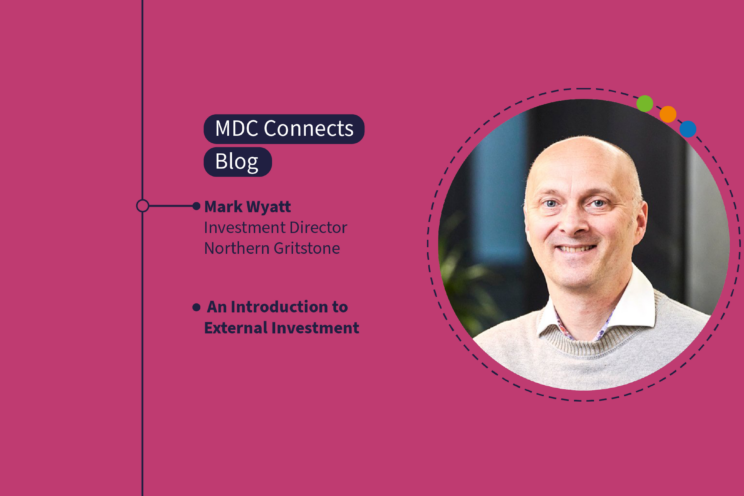An Introduction to External Investment
Mark Wyatt, Investment Director, Northern Gritstone
05 June 2024


Northern Gritstone is an investment company, dedicated to supporting ambitious science and technology-enabled businesses in the North of England.
Its philosophy is ‘profit with purpose’ combining strong returns for investors with wider positive, societal and economic impact, including Levelling Up and high-skilled job creation.
Northern Gritstone and NG Innovation Services support some of the UK’s fastest growing sectors, offering ‘Capital+++’, connecting early-stage founders with funding and expertise through links to industry-leading partners and Northern Gritstone’s founding universities of Manchester, Leeds and Sheffield.
By Mark Wyatt, Investment Director, Northern Gritstone
Why Raise Funding?
At the outset, it is worth considering some fundamental questions about raising money, particularly the issues that drive the need for investment. It could be that funding requirements are well beyond individual means or that an organisation has simply run out of money. These are difficult situations which demand careful evaluation.
Positive reasons for seeking external capital – to grow the business faster, to reduce risk, to increase shareholder value, for example – are the best benchmarks for making good decisions. Adding value is a sound basis for pursuing funding.
What to Consider: The Entrepreneurial Perspective
These considerations will vary according to an organisation’s circumstances and levels of ambition, and many of these will be personal.
For example, an early-stage opportunity could mean leaving the security of a full-time, well-paid role. The amount of risk and time commitment needs to be realistically assessed; raising external money could involve sacrificing a certain amount of control in the company.
Where to Raise the Funding
Institutional investment is by no means the only source of capital for life sciences organisations. Options range from ‘sweat equity’ – temporarily working for no pay – to crowdfunding; grants to family and friends’ investment; banks to angel investors; incubators to employee funding.
The fundamental factor is to have a coherent investment plan in place from Day One. From pre-seed through to a late-stage business, prior knowledge of the types of finance available at critical points of the journey will help make for a smoother, more direct line of travel.
Longer-term Equity Planning
Businesses at an early stage in therapeutics tend to be engaged in developing an idea with a strong emphasis on research. As they progress towards a sales focus, the original staffing profile may not suit this commercialising stage. It’s important to recognise this fact early on and be prepared to transition the company’s skills’ base as necessary.
There is a classic question that is often posed in business planning: would you rather have a bigger slice of a small pie, or a smaller slice of a big pie? The individual answer should inform planning around where and how capital is sourced, and what growth is required.
It is also always worth remembering that the valuation of shares from an individual’s perspective remains theoretical until the actual exit event.
Ideas are Important, but Execution is Essential
Statistics show that venture capital providers invest in somewhere between one to three percent of the opportunities presented to them. These numbers reveal that even the best innovations can falter without the promise of effective execution.
The good news is that therapeutics organisations are usually strong on research. Applying that thorough-going approach to exploring investment providers will considerably increase the chances of getting in front of the right people.
Different investors are seeking different things. Looking for capital providers who are already backing ideas comparable to your own in similar technology fields is an excellent way of finding the most promising investment candidates.
What Matters to Venture Capitalists
The five key areas which inform the decision of a venture capital firm to invest are:
- People
- Market
- Return
- Technology
- Business model
The importance of people is paramount for many providers. ‘I’d rather have a great team managing mediocre technology than a great technology with a mediocre team’ is a commonly held view in venture capital. The ‘people factor’ is consequently a key part of a strong proposition.
In terms of the Market, venture capital is looking for a maximised return at exit; showing that an idea is destined to perform in a large market can therefore be a very persuasive argument. Equally, if an idea has the potential to dominate a niche market, this can also attract interest.
It is clearly important to bring forward a technology idea that will differentiate itself positively from the status quo in a marketplace. Therefore the proposition should credibly justify the opportunity’s unique advantage clearly and persuasively,
A strong business model is also essential. Venture capital providers prefer to see distinct milestones across the investment period – defined points which show how much money is required to get from A to B.
IP Position and Strategy
For venture capital providers, a strong IP position is not simply about patents. It is essential that the IP speaks to the value proposition of the business. It must be clear that the IP element is credible and an integral part of the strategy.
Suitable IP arrangements are important. Particularly for spin-outs, investors need to see a clear audit trail that verifies IP.
Market Reality
Generally, venture capital is interested in large market opportunities. Demonstrating that the target market for your innovation has been well researched – and providing evidence that it has an appetite for the idea – is crucial.
The overall value of a given market is not a useful figure for venture capitalists; they want to see how much of that market you can realistically claim for your opportunity.
Business Model
A persuasive model is based on showing a domain and knowledge-led route to the market. The investor needs to be convinced that you have a credible plan in place, to move from your existing position to one where the sales are growing and returns are building.
There needs to be evidence of a good market fit for your product, as well as real proof of traction. The revenue model must be equally credible, showing where value will accrue at different points.
In Summary
Good venture capital providers are looking to see motivated management teams with the right amount of value in the right hands. Fair, realistic valuations form the basis of a good relationship, where everyone has their financial aims met.
The biotech sector can show many precedent transactions. There is an opportunity to refer to these in building a case for how your company can move from point to point with an investor – from your current position to a much more valuable one in future.
Mark Wyatt, Investment Director, Northern Gritstone
Hear more in episode two of the MDC Connects 2024 webinar series, ‘Unlocking the Secrets of Medicine Commercialisation’ here.




